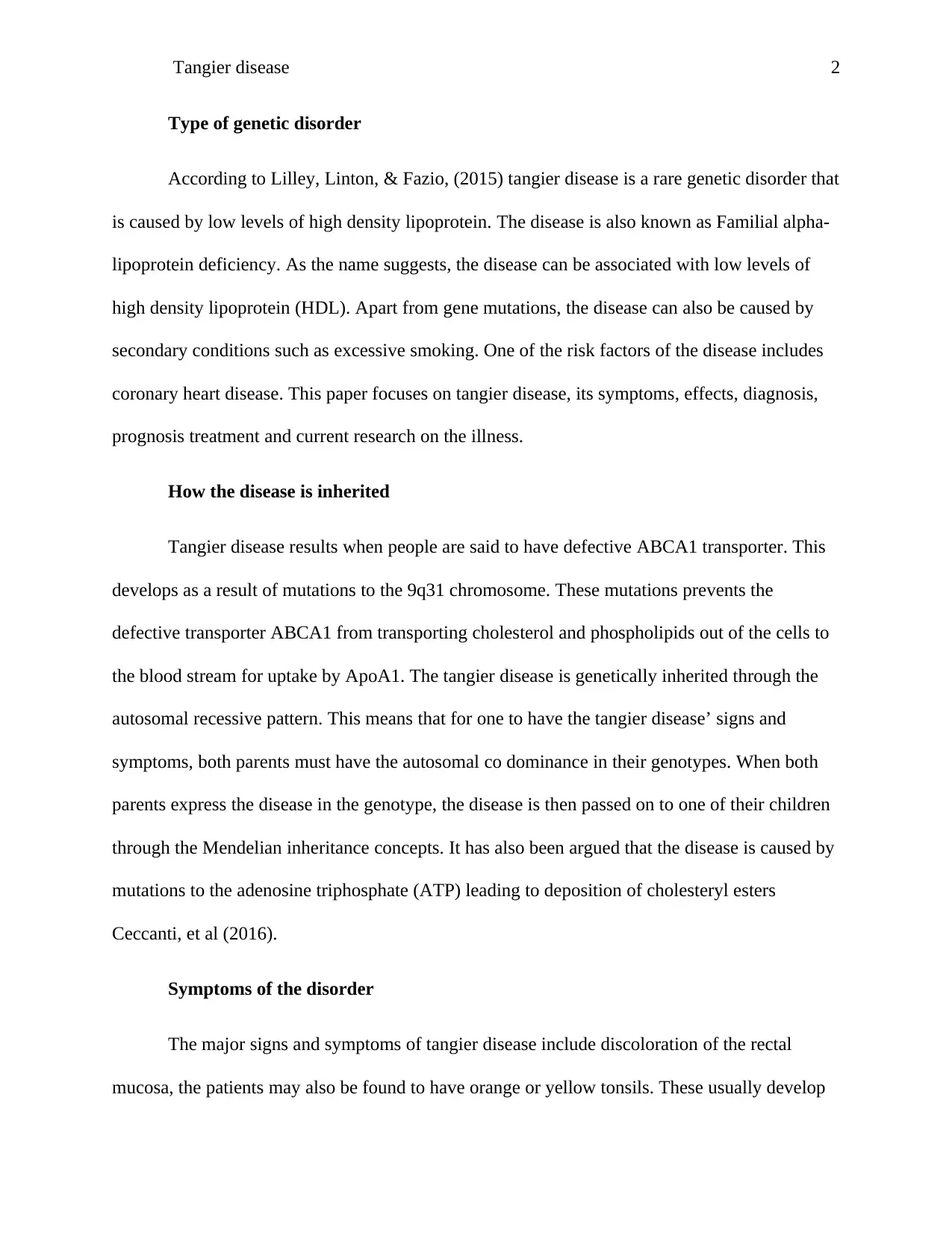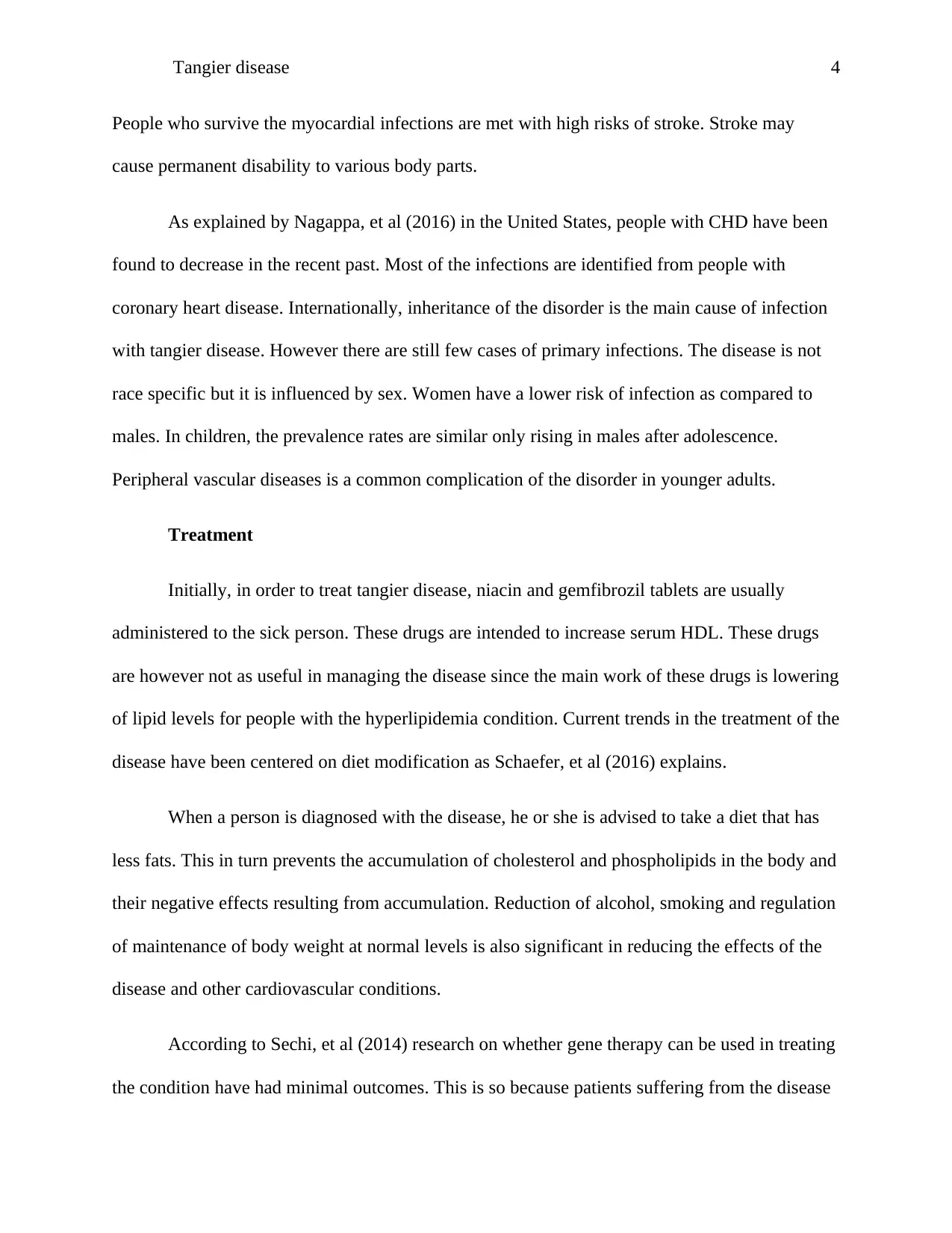Analysis of Tangier Disease: Symptoms, Diagnosis, and Current Research
VerifiedAdded on 2021/06/16
|7
|1600
|42
Report
AI Summary
This report provides a comprehensive overview of Tangier disease, a rare genetic disorder characterized by low levels of high-density lipoprotein (HDL). The report delves into the genetic inheritance of the disease, focusing on mutations in the ABCA1 transporter gene and the autosomal recessive inheritance pattern. It details the symptoms, including discoloration of the rectal mucosa, orange or yellow tonsils, and peripheral neuropathy, and discusses the effects such as increased HDL catabolism and increased risk of coronary heart disease and stroke. The diagnosis involves assessing HDL deficiency and specialized tests like corneal clouding and enlarged organs. The prognosis highlights the risk of high mortality due to cardiac infections, with treatment focusing on diet modification, and the current research exploring pharmacological approaches to increase HDL levels and inhibit cholesterol ester transfer protein (CETP). The report concludes by emphasizing the rarity of the disease and the ongoing research efforts.

Running head: Tangier disease 1
Tangier Disease
Sarah Sarwar
Institutional affiliation
Tangier Disease
Sarah Sarwar
Institutional affiliation
Paraphrase This Document
Need a fresh take? Get an instant paraphrase of this document with our AI Paraphraser

Tangier disease 2
Type of genetic disorder
According to Lilley, Linton, & Fazio, (2015) tangier disease is a rare genetic disorder that
is caused by low levels of high density lipoprotein. The disease is also known as Familial alpha-
lipoprotein deficiency. As the name suggests, the disease can be associated with low levels of
high density lipoprotein (HDL). Apart from gene mutations, the disease can also be caused by
secondary conditions such as excessive smoking. One of the risk factors of the disease includes
coronary heart disease. This paper focuses on tangier disease, its symptoms, effects, diagnosis,
prognosis treatment and current research on the illness.
How the disease is inherited
Tangier disease results when people are said to have defective ABCA1 transporter. This
develops as a result of mutations to the 9q31 chromosome. These mutations prevents the
defective transporter ABCA1 from transporting cholesterol and phospholipids out of the cells to
the blood stream for uptake by ApoA1. The tangier disease is genetically inherited through the
autosomal recessive pattern. This means that for one to have the tangier disease’ signs and
symptoms, both parents must have the autosomal co dominance in their genotypes. When both
parents express the disease in the genotype, the disease is then passed on to one of their children
through the Mendelian inheritance concepts. It has also been argued that the disease is caused by
mutations to the adenosine triphosphate (ATP) leading to deposition of cholesteryl esters
Ceccanti, et al (2016).
Symptoms of the disorder
The major signs and symptoms of tangier disease include discoloration of the rectal
mucosa, the patients may also be found to have orange or yellow tonsils. These usually develop
Type of genetic disorder
According to Lilley, Linton, & Fazio, (2015) tangier disease is a rare genetic disorder that
is caused by low levels of high density lipoprotein. The disease is also known as Familial alpha-
lipoprotein deficiency. As the name suggests, the disease can be associated with low levels of
high density lipoprotein (HDL). Apart from gene mutations, the disease can also be caused by
secondary conditions such as excessive smoking. One of the risk factors of the disease includes
coronary heart disease. This paper focuses on tangier disease, its symptoms, effects, diagnosis,
prognosis treatment and current research on the illness.
How the disease is inherited
Tangier disease results when people are said to have defective ABCA1 transporter. This
develops as a result of mutations to the 9q31 chromosome. These mutations prevents the
defective transporter ABCA1 from transporting cholesterol and phospholipids out of the cells to
the blood stream for uptake by ApoA1. The tangier disease is genetically inherited through the
autosomal recessive pattern. This means that for one to have the tangier disease’ signs and
symptoms, both parents must have the autosomal co dominance in their genotypes. When both
parents express the disease in the genotype, the disease is then passed on to one of their children
through the Mendelian inheritance concepts. It has also been argued that the disease is caused by
mutations to the adenosine triphosphate (ATP) leading to deposition of cholesteryl esters
Ceccanti, et al (2016).
Symptoms of the disorder
The major signs and symptoms of tangier disease include discoloration of the rectal
mucosa, the patients may also be found to have orange or yellow tonsils. These usually develop

Tangier disease 3
due to formation of cholesterol esters. The cholesterol esters may also be found in the liver,
spleen and the bone marrow. Patients of tangier disease also exhibit abnormalities such as
peripheral neuropathy and opacities. Among the effects of the disease is increase of HDL
catabolism. The HDL cholesterol may reach worrying levels which are below 5mg/dl.
Apparently, very little can be done to correct the situation. The disease is a risk factor for
infections such as stroke and coronary heart disease.
Diagnosis of individual with disorder
One can be diagnosed with tangier disease when they are found to have high density
lipoprotein deficiency. These are lipoproteins formed from the combination of cholesterol and
phospholipids. Tangier disease results in defective transporters which in turn makes people with
the disease not to have enough lipoproteins. The cholesterol that accumulates in the cells then
starts having adverse effects in the body such as formation of cholyestyl esters. It also leads to
accumulation of cholesterol and phospholipids at the lymph nodes and other body parts which
leads to formation of yellow tonsils. The accumulation may also result into increase in size in the
affected body parts. Some of the specialty tests that leads to tangier disease diagnosis includes
clouding of the cornea, high amount of fat in the blood, enlarged spleen and liver and disturbance
in the nerves argues Puntoni, Sbrana, Bigazzi, & Sampietro, (2012).
Prognosis
The prognosis and likely impacts of tangier disease include risk of high mortality and due
to cardiac infections. The main cardiac diseases that result from the infection of tangier disease
are coronary heart disease and atherosclerosis. Statistics have proven that generally, CHD is one
of the biggest cause of death in many industrialized countries through myocardial infections.
due to formation of cholesterol esters. The cholesterol esters may also be found in the liver,
spleen and the bone marrow. Patients of tangier disease also exhibit abnormalities such as
peripheral neuropathy and opacities. Among the effects of the disease is increase of HDL
catabolism. The HDL cholesterol may reach worrying levels which are below 5mg/dl.
Apparently, very little can be done to correct the situation. The disease is a risk factor for
infections such as stroke and coronary heart disease.
Diagnosis of individual with disorder
One can be diagnosed with tangier disease when they are found to have high density
lipoprotein deficiency. These are lipoproteins formed from the combination of cholesterol and
phospholipids. Tangier disease results in defective transporters which in turn makes people with
the disease not to have enough lipoproteins. The cholesterol that accumulates in the cells then
starts having adverse effects in the body such as formation of cholyestyl esters. It also leads to
accumulation of cholesterol and phospholipids at the lymph nodes and other body parts which
leads to formation of yellow tonsils. The accumulation may also result into increase in size in the
affected body parts. Some of the specialty tests that leads to tangier disease diagnosis includes
clouding of the cornea, high amount of fat in the blood, enlarged spleen and liver and disturbance
in the nerves argues Puntoni, Sbrana, Bigazzi, & Sampietro, (2012).
Prognosis
The prognosis and likely impacts of tangier disease include risk of high mortality and due
to cardiac infections. The main cardiac diseases that result from the infection of tangier disease
are coronary heart disease and atherosclerosis. Statistics have proven that generally, CHD is one
of the biggest cause of death in many industrialized countries through myocardial infections.
⊘ This is a preview!⊘
Do you want full access?
Subscribe today to unlock all pages.

Trusted by 1+ million students worldwide

Tangier disease 4
People who survive the myocardial infections are met with high risks of stroke. Stroke may
cause permanent disability to various body parts.
As explained by Nagappa, et al (2016) in the United States, people with CHD have been
found to decrease in the recent past. Most of the infections are identified from people with
coronary heart disease. Internationally, inheritance of the disorder is the main cause of infection
with tangier disease. However there are still few cases of primary infections. The disease is not
race specific but it is influenced by sex. Women have a lower risk of infection as compared to
males. In children, the prevalence rates are similar only rising in males after adolescence.
Peripheral vascular diseases is a common complication of the disorder in younger adults.
Treatment
Initially, in order to treat tangier disease, niacin and gemfibrozil tablets are usually
administered to the sick person. These drugs are intended to increase serum HDL. These drugs
are however not as useful in managing the disease since the main work of these drugs is lowering
of lipid levels for people with the hyperlipidemia condition. Current trends in the treatment of the
disease have been centered on diet modification as Schaefer, et al (2016) explains.
When a person is diagnosed with the disease, he or she is advised to take a diet that has
less fats. This in turn prevents the accumulation of cholesterol and phospholipids in the body and
their negative effects resulting from accumulation. Reduction of alcohol, smoking and regulation
of maintenance of body weight at normal levels is also significant in reducing the effects of the
disease and other cardiovascular conditions.
According to Sechi, et al (2014) research on whether gene therapy can be used in treating
the condition have had minimal outcomes. This is so because patients suffering from the disease
People who survive the myocardial infections are met with high risks of stroke. Stroke may
cause permanent disability to various body parts.
As explained by Nagappa, et al (2016) in the United States, people with CHD have been
found to decrease in the recent past. Most of the infections are identified from people with
coronary heart disease. Internationally, inheritance of the disorder is the main cause of infection
with tangier disease. However there are still few cases of primary infections. The disease is not
race specific but it is influenced by sex. Women have a lower risk of infection as compared to
males. In children, the prevalence rates are similar only rising in males after adolescence.
Peripheral vascular diseases is a common complication of the disorder in younger adults.
Treatment
Initially, in order to treat tangier disease, niacin and gemfibrozil tablets are usually
administered to the sick person. These drugs are intended to increase serum HDL. These drugs
are however not as useful in managing the disease since the main work of these drugs is lowering
of lipid levels for people with the hyperlipidemia condition. Current trends in the treatment of the
disease have been centered on diet modification as Schaefer, et al (2016) explains.
When a person is diagnosed with the disease, he or she is advised to take a diet that has
less fats. This in turn prevents the accumulation of cholesterol and phospholipids in the body and
their negative effects resulting from accumulation. Reduction of alcohol, smoking and regulation
of maintenance of body weight at normal levels is also significant in reducing the effects of the
disease and other cardiovascular conditions.
According to Sechi, et al (2014) research on whether gene therapy can be used in treating
the condition have had minimal outcomes. This is so because patients suffering from the disease
Paraphrase This Document
Need a fresh take? Get an instant paraphrase of this document with our AI Paraphraser

Tangier disease 5
do not have any significant challenges in the genes that is utilized in the conversion of HDL with
the main problem being in the transportation. In addition, many cell processes in the conversion
and transport of HDL still remain unknown. However, in women, estrogen replacement therapy
is available for women who have passed menopause as it can help to reduce cholesterol levels.
Current research
Current and ongoing research has actually identified carbohydrates and unsaturated fats
as co morbidities involved in increasing the risk for people with tangier disease. Pharmacological
approaches have been centered on increasing HDL levels and inhibiting cholestryl ester transfer
protein (CETP). Research has helped to produce a drug CETP inhibitor torcetrabip drug which
can increase and decrease HDL and LDL respectively. The National Organization for Rare
Disorders (NORD) in collaboration with the National Institute of Health has undertaken research
on the disease, its prevalence rates and possible medications.
In conclusion, tangier disease is a rare disorder with less than 100 people infected in the
world. The disease is said to have originated in Virginia. Tangier disease is a genetic disorder
which occurs when someone inherits two chromosomes of the same trait from each parent. The
disease can be treated using niacin. According to Muratsu, et al (2018) the disease increases risk
of coronary heart disease, atherosclerosis and stroke.
do not have any significant challenges in the genes that is utilized in the conversion of HDL with
the main problem being in the transportation. In addition, many cell processes in the conversion
and transport of HDL still remain unknown. However, in women, estrogen replacement therapy
is available for women who have passed menopause as it can help to reduce cholesterol levels.
Current research
Current and ongoing research has actually identified carbohydrates and unsaturated fats
as co morbidities involved in increasing the risk for people with tangier disease. Pharmacological
approaches have been centered on increasing HDL levels and inhibiting cholestryl ester transfer
protein (CETP). Research has helped to produce a drug CETP inhibitor torcetrabip drug which
can increase and decrease HDL and LDL respectively. The National Organization for Rare
Disorders (NORD) in collaboration with the National Institute of Health has undertaken research
on the disease, its prevalence rates and possible medications.
In conclusion, tangier disease is a rare disorder with less than 100 people infected in the
world. The disease is said to have originated in Virginia. Tangier disease is a genetic disorder
which occurs when someone inherits two chromosomes of the same trait from each parent. The
disease can be treated using niacin. According to Muratsu, et al (2018) the disease increases risk
of coronary heart disease, atherosclerosis and stroke.

Tangier disease 6
REFERENCES
Ceccanti, M., Cambieri, C., Frasca, V., Onesti, E., Biasiotta, A., Giordano, C., ... & Inghilleri, M.
(2016). A Novel mutation in ABCA1 gene causing tangier disease in an italian family
with uncommon neurological presentation. Frontiers in neurology, 7, 185.
Lilley, J. S., Linton, M. F., & Fazio, S. (2015). Genetic disorders of hdl metabolism.
In Dyslipidemias (pp. 221-233). Humana Press, Totowa, NJ.
Muratsu, J., Koseki, M., Masuda, D., Yasuga, Y., Tomoyama, S., Ataka, K., ... & Hattori, H.
(2018). Accelerated Atherogenicity in Tangier Disease. Journal of atherosclerosis and
thrombosis, 43257.
Nagappa, M., Taly, A. B., Mahadevan, A., Pooja, M., Bindu, P. S., Chickabasaviah, Y. T., ... &
Sinha, S. (2016). Tangier's disease: An uncommon cause of facial weakness and non-
length dependent demyelinating neuropathy. Annals of Indian Academy of
Neurology, 19(1), 137.
Puntoni, M., Sbrana, F., Bigazzi, F., & Sampietro, T. (2012). Tangier disease. American Journal
of Cardiovascular Drugs, 12(5), 303-311.
Schaefer, E., Klementowicz, P., Ganda, O., Polisecki, E., Asztalos, B., Pandya, A., & Hegele, R.
(2016). The Linkage of Tangier Disease with Premature Coronary Artery Disease:
Relationship with Low Density Lipoproteins and Hypersplenism. Journal of Clinical
Lipidology, 10(3), 677.
REFERENCES
Ceccanti, M., Cambieri, C., Frasca, V., Onesti, E., Biasiotta, A., Giordano, C., ... & Inghilleri, M.
(2016). A Novel mutation in ABCA1 gene causing tangier disease in an italian family
with uncommon neurological presentation. Frontiers in neurology, 7, 185.
Lilley, J. S., Linton, M. F., & Fazio, S. (2015). Genetic disorders of hdl metabolism.
In Dyslipidemias (pp. 221-233). Humana Press, Totowa, NJ.
Muratsu, J., Koseki, M., Masuda, D., Yasuga, Y., Tomoyama, S., Ataka, K., ... & Hattori, H.
(2018). Accelerated Atherogenicity in Tangier Disease. Journal of atherosclerosis and
thrombosis, 43257.
Nagappa, M., Taly, A. B., Mahadevan, A., Pooja, M., Bindu, P. S., Chickabasaviah, Y. T., ... &
Sinha, S. (2016). Tangier's disease: An uncommon cause of facial weakness and non-
length dependent demyelinating neuropathy. Annals of Indian Academy of
Neurology, 19(1), 137.
Puntoni, M., Sbrana, F., Bigazzi, F., & Sampietro, T. (2012). Tangier disease. American Journal
of Cardiovascular Drugs, 12(5), 303-311.
Schaefer, E., Klementowicz, P., Ganda, O., Polisecki, E., Asztalos, B., Pandya, A., & Hegele, R.
(2016). The Linkage of Tangier Disease with Premature Coronary Artery Disease:
Relationship with Low Density Lipoproteins and Hypersplenism. Journal of Clinical
Lipidology, 10(3), 677.
⊘ This is a preview!⊘
Do you want full access?
Subscribe today to unlock all pages.

Trusted by 1+ million students worldwide

Tangier disease 7
Sechi, A., Dardis, A., Zampieri, S., Rabacchi, C., Zanoni, P., Calandra, S., ... & Platt, F. (2014).
Effects of miglustat treatment in a patient affected by an atypical form of Tangier
disease. Orphanet journal of rare diseases, 9(1), 143.
Sechi, A., Dardis, A., Zampieri, S., Rabacchi, C., Zanoni, P., Calandra, S., ... & Platt, F. (2014).
Effects of miglustat treatment in a patient affected by an atypical form of Tangier
disease. Orphanet journal of rare diseases, 9(1), 143.
1 out of 7
Your All-in-One AI-Powered Toolkit for Academic Success.
+13062052269
info@desklib.com
Available 24*7 on WhatsApp / Email
![[object Object]](/_next/static/media/star-bottom.7253800d.svg)
Unlock your academic potential
Copyright © 2020–2025 A2Z Services. All Rights Reserved. Developed and managed by ZUCOL.